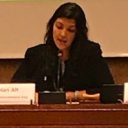The World Health Organisation (WHO) estimates that 15 percent of the global population (or over 1 billion people) have some form of disability. These figures can grow even larger due to natural disasters or conflicts, when more people are exposed to debilitating accidents or violence. Despite general awareness amongst different actors that persons with disabilities are more likely to become subject to a vast range of risks during humanitarian crises, few practical actions are usually taken to reduce these perils. Many actors do not comply with the recommendations from international agreements on ensuring the participation of persons with disabilities in programming, nor do they recruit technical experts on inclusion.
With that in mind, this article discusses the exclusion of persons with disabilities in the context of humanitarian action. This article will analyse how humanitarian crises exacerbate social exclusion, resulting in increased vulnerability of persons with disabilities. It shall address the three main causes for this issue, by drawing on examples from recent experiences in Iraq.[1]
The vicious cycle between disability and poverty
According to the United Nation’s Convention on the Rights of Persons with Disabilities (CRPD) and to experts, disability is the combination of: 1) the individual’s impairment; 2) the barriers in the environment (lack of physical and communications accessibility, negative attitudes, absence of laws and specific policies); and 3) the individual’s social role (sex, financial situation, access to political participation, etc).
Several studies have supported the existence of a causal relationship between disability and poverty. Out of the estimated 1 billion individuals living with a type of disability in the world, 80 percent live in developing countries.[2] Moreover: it was found that 20 percent of people living in extreme poverty have a disability. Finally, women in developing countries are more likely to have a disability during their lifetime (UN, 2010).
Other figures also corroborate the existence of a vicious cycle between the disability and poverty. Children and adults from developing countries are more exposed to diseases and accidents (e.g. traffic and work related injuries). They often do not have access to adequate healthcare, nor enjoy adequate road safety, vaccinations, disease prevention measures or where to seek medical assistance. Concurrently, persons with disabilities face relevant barriers to access social protection and health care services, quality education and livelihood opportunities, increasing their chances of remaining in poverty.
Humanitarian crises often deepen the scenario of exclusion due to, among other issues, the destruction of physical structures, the disruption of public services, economic hardship and political, religious or ethnic disputes. Simultaneously, they can increase the incidence of accidents, violence, and disease outbreaks. These factors, on the other hand, may lead to an increase of contexts leading to disability and the severity of experiencing the consequences of existing disabilities.
Disability amidst a Humanitarian Crisis: The Case of Iraq
During humanitarian crises, international organisations often lead most of the emergency response. This was the case in Iraq during the military operations against the jihadist group Islamic State and the Levant (ISIS). In 2014, ISIS took control of large swaths of territory, including Fallujah, Hawija and Mosul. As of late 2017, over 3 million people became internally displaced in the country as a consequence of the mass-scale violence. An even larger number was in need of humanitarian assistance.
A Doubly Invisible Population
Even though most of the response has been led by the UN and international organisations, persons with disabilities are still being overwhelmingly excluded from the most basic services. For instance, there is no reliable information regarding the number of persons with disabilities affected by the conflict. According to the data collected by different camp managers in the Mosul area, the rates are below 1 percent of all Internally Displaced Persons (IDPs). This figure is far below the WHO’s estimation of 15 percent prevalence rate of disabilities within a population, which raises questions on the adequacy of data collection methods.
Upon arrival in a IDP camp, the head of household is usually interviewed by the camp management team. The questionnaire asks about the existence of a person with ‘physical’ or ‘mental’ disability[3] in the household, however, due to stigma, very few interviewees provide this information. Therefore, this methodology is inadequate to correctly identify the number of persons with disabilities arriving in these camps. Furthermore, the tools used by different actors for needs assessment cannot accurately collect data on intellectual impairments and mental health conditions.
There is also a blatant lack of involvement of groups of people with disabilities (DPOs) in planning, implementation and monitoring of humanitarian projects, as well as a limited number of technical experts on inclusion working for mainstream organisations. These aspects prevent projects, activities and services from being sustainable and from meeting minimum quality standards. Projects are, thus, designed without taking the specific needs of persons with disabilities into account, resulting in their overall exclusion and invisibility to service providers.
Some practical problems arising from the issues mentioned above in Iraq are: 1) the lack of security during and after displacement (between areas controlled by ISIS and the government controlled locations); and 2) the barriers to access basic services such as WASH, shelter, food, education, child protection and Gender Based Violence, among others.
Increased Security Risks and Exclusion from Basic Services
During the perilous displacement routes, persons with disabilities were exposed to additional risks, in particular those with mobility and speech restrictions, and those using assistive devices (e.g. wheelchairs, crutches, walkers). For instance, in the military checkpoints, male adults and boys above 13 years old were separated from women and thoroughly interrogated for security screening purposes, even those with disabilities. Being in a stressful environment without a relative by their side to assist with communications, could lead to abuses by the security forces or even arrest for suspicion of affiliation with ISIS. Furthermore, after arriving in the camps or in the host communities, children and women with disabilities were vulnerable to violence, sexual abuse and mistreatment.
Lack of physical accessibility and absence of communication, information and education materials in accessible formats were common in most camps, resulting in overall exclusion of persons with disabilities from basic of services. In some camps, adult diapers were distributed for persons with disabilities as an alternative to accessible toilets, which was both discriminatory and humiliating. Furthermore, distributions of food and non-food items were disorganised, dangerous and inaccessible for most people.
Persons with disabilities were also overwhelmingly excluded from activities such as child protection, GBV services, and psychosocial support. For instance, children with disabilities were often not allowed in many child friendly spaces (where leisure activities and psychological support would take place) without the presence of a parent. Moreover, these structures did not meet accessibility standards, nor was the staff trained on how to include children with disabilities in activities. Consequently, these children were often found by social workers inside their tents, sometimes even tied to the furniture.
Conclusions
The exclusion of persons with disabilities from humanitarian assistance exposes them to protection risks and perpetuates stigma and prejudice. This, consequently, violates a number of international agreements, such as the Universal Declaration of Human Rights, the Convention on the Rights of Persons with Disabilities, the 1951 UN Convention on Refugees, among others.
In the last few years, there has been an international move to change that scenario. However, there are still many challenges to ensure that any improvements are implemented at field level. With this in mind, a follow-up article will analyse this move, its challenges and the way forward to guarantee the rights of persons with disabilities even in the most complex humanitarian responses.
This article is based on the author’s personal field experience. It does not reflect the views of any of her previous employers.
[1] Iraq was selected as a case study due to the author’s work experience in the country.
[2] Despite the comprehensive disability definition used in this article, focusing on the limitations of functionalities of an individual based on their impairment is the approach most commonly adopted when collecting data on persons with disabilities.
[3] Although this is not appropriate language, these were the exact terms used in the questionnaire.






